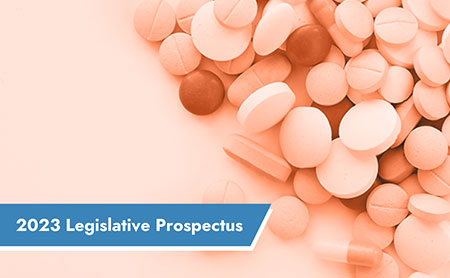Opioid Crisis: Continuing Efforts to Prevent Overdose
December 12, 2022
Introduction
 Drug overdoses, both fatal and nonfatal, continue to increase nationally, with the majority of overdose deaths involving opioids. Overdose deaths also surged during the COVID-19 pandemic. In 2020, there were 91,799 fatal drug overdoses in the United States, an increase of 31% from the previous year. Preliminary data for 2021 indicate that there were more than 105,000 lives lost that year. The increase in drug overdose deaths may be the result of factors including social isolation, addiction treatment interruption, and stronger synthetic opioids like fentanyl becoming more prevalent in the illicit drug supply.
Drug overdoses, both fatal and nonfatal, continue to increase nationally, with the majority of overdose deaths involving opioids. Overdose deaths also surged during the COVID-19 pandemic. In 2020, there were 91,799 fatal drug overdoses in the United States, an increase of 31% from the previous year. Preliminary data for 2021 indicate that there were more than 105,000 lives lost that year. The increase in drug overdose deaths may be the result of factors including social isolation, addiction treatment interruption, and stronger synthetic opioids like fentanyl becoming more prevalent in the illicit drug supply.
States and territories are implementing several policies to reduce fatal overdoses, including decriminalizing fentanyl test strips, increasing naloxone access through co-prescribing requirements, and supporting community distribution through schools.
Legislative Trends
Fentanyl Test Strips
A substantial increase in the presence of the synthetic opioid fentanyl in the illicit drug supply was a major contributor to the rise in overdoses. Fentanyl is estimated to be 50 times stronger than heroin and 100 times stronger than morphine. Fentanyl is tasteless and odorless, making it extremely difficult to detect in drugs without using fentanyl test strips. These test strips are inexpensive, disposable, items that can detect the presence of fentanyl or fentanyl analogs in a substance. In many states, using fentanyl test strips may be illegal under drug paraphernalia laws that prohibit items used to test drugs; however, this is changing.
In 2022, at least eleven states, (Alabama, Connecticut, Georgia, Louisiana, Minnesota, Nevada, New Mexico, Pennsylvania, Tennessee, West Virginia, and Wisconsin) enacted legislation to remove fentanyl test strips from their paraphernalia laws. In Nevada, New Mexico, and Connecticut, the enacted legislation included language to remove fentanyl test strips and similar items from their drug paraphernalia laws.
Naloxone Co-Prescribing
Naloxone is an FDA-approved opioid antagonist that rapidly reverses the effects of an opioid overdose when administered in a timely manner. This prepackaged nasal spray also goes by brand names Narcan and Kloxxado, and can quickly restore normal breathing to a person experiencing an opioid overdose. While the number of pharmacy-obtained opioid-related overdoses has fallen with the national decrease in prescription opioids, they still account for many of the opioid-related fatalities. To lower the risk of opioid overdose linked to pharmacy-obtained opioids, several states are requiring or recommending that people prescribed high dosages of opioids be co-prescribed naloxone.
In 2022, Illinois and New York joined 18 other states that have enacted legislation to require or recommend that naloxone be co-prescribed, either with an opioid or on its own if a patient has a history of opioid use disorder or overdose. Under New York’s law, opioid prescribers are required to co-prescribe opioid antagonists, like naloxone, with new opioid prescriptions when certain patient risk factors are present, such as a history of substance use disorder, concurrent use of high-risk medications, or a high dosage of opioids.
Several states with existing co-prescribing laws expanded when and where naloxone must be co-prescribed. Washington state, which already required co-prescribing when a patient has certain high-risk factors, passed legislation requiring emergency department practitioners to dispense opioid overdose reversal medication, like naloxone, when a patient presents with high-risk symptoms. In addition, a new Kentucky law requires pharmacies that sell hypodermic needles to also offer a prescription for naloxone when dispensing needles.
Naloxone in Schools
Another way communities are attempting to reduce overdoses and broaden access to naloxone is by allowing school nurses to have and administer naloxone on site. Doing so will allow school nurses to quickly administer naloxone, reverse an individual’s life-threatening respiratory depression, and save that person from a potentially fatal overdose.
In 2022, six states (Connecticut, Florida, Iowa, Maine, Minnesota, and Nevada) have joined 24 others in enacting legislation that allows access to naloxone in schools. Maine’s legislation states that schools may possess and keep naloxone on the premises, and that the school district or school board must promulgate policies on the possession of naloxone in schools. Many naloxone laws related to schools tend to address naloxone possession and use in primary and secondary schools. However, in Maryland, Washington state, and Wisconsin, the laws address both primary and secondary schools as well as access to naloxone in higher education institutions.
Looking Ahead
ASTHO expects states and territories to continue considering and adopting laws addressing the opioid epidemic, including those that:
- Decriminalize drug-checking equipment, like fentanyl test strips.
- Provide naloxone, target community distribution to those who are at a high risk of overdosing, and allow for continuous naloxone access, such as distribution from vending machines and in syringe service programs.
- Expand the use of medication for opioid used disorder and naloxone access in diversion programs and correctional settings.
- Establish overdose prevention centers, also known as supervised consumption sites, which provide a safe space for people to consume pre-obtained drugs in controlled settings, with staff present, access to sterile supplies, and availability of referrals to primary and behavioral health care and social services.